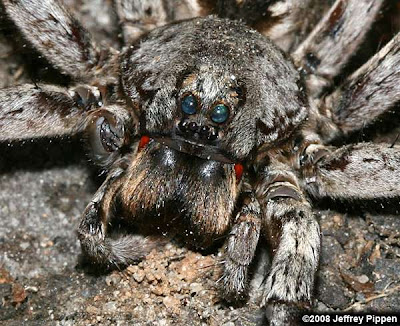As per Wikipedia, "The coconut crab, Birgus latro, is a species of terrestrial hermit crab, also known as the robber crab or palm thief. It is the largest land-living arthropod in the world, and is probably at the upper size limit of terrestrial animals with exoskeletons in today's atmosphere at a weight of up to 4.1 kg (9.0 lb). It is found on islands across the Indian Ocean and parts of the Pacific Ocean as far east as the Gambier Islands, mirroring the distribution of the coconut palm; it has been extirpated from most areas with a significant human population, including mainland Australia and Madagascar."
The Robber (or Coconut) Crab, Birgus latro, is not only the world’s largest land invertebrate, it’s also a thief that climbs trees at night and steals coconuts! These huge crustaceans of the south-west Pacific and Indian Oceans, can grow to a length of 60 cm (2 ft), from head to tail. They sneak out of their burrows at night, climb the trunks of coconut palms or other fruit trees, and snip off the coconut or fruit with their two giant pincers. They climb back down the tree and gather up the food, then use the pincers to chip at the coconut until it opens.
It is named as the "Coconut Crabs" as it can break a coconut with its strong pincers. They have eight legs and the other two legs have claws, which help them to climb a coconut tree. These species can be of tinged red or deep blue. The females of these species have three large feathery appendages to support the eggs. The length of their body can grow up to a size of 40 cm and weigh up to 17 kg. Their body structure resembles to that of an insect as it lives on the land. The young ones use their shell to protect themselves. They also use the broken shell of coconut in their moulting stages. They have an antenna, which consists of aesthetascs and this provides them an excellent sense of smell.
The coconut crabs mature, either when they grow up to 3.5 meter in size or when they grow up to age of 5 years. The mating season for these species is between May to September. The male and the female are known to fight during the time of mating. During the mating process the male pushes the female onto her back. After that, it places the sperm-sac over the gonopore of the female. The female holds the eggs for (1 to 2) weeks till it gets fertilized. Moreover, the eggs take (3 to 6) weeks to get mature. When the eggs get transformed into juvenile crab, it leaves secretly for (1 to 2) years in their burrows. They have a life span of around 60 years.
The Robber (or Coconut) Crab, Birgus latro, is not only the world’s largest land invertebrate, it’s also a thief that climbs trees at night and steals coconuts! These huge crustaceans of the south-west Pacific and Indian Oceans, can grow to a length of 60 cm (2 ft), from head to tail. They sneak out of their burrows at night, climb the trunks of coconut palms or other fruit trees, and snip off the coconut or fruit with their two giant pincers. They climb back down the tree and gather up the food, then use the pincers to chip at the coconut until it opens.
It is named as the "Coconut Crabs" as it can break a coconut with its strong pincers. They have eight legs and the other two legs have claws, which help them to climb a coconut tree. These species can be of tinged red or deep blue. The females of these species have three large feathery appendages to support the eggs. The length of their body can grow up to a size of 40 cm and weigh up to 17 kg. Their body structure resembles to that of an insect as it lives on the land. The young ones use their shell to protect themselves. They also use the broken shell of coconut in their moulting stages. They have an antenna, which consists of aesthetascs and this provides them an excellent sense of smell.
The coconut crabs mature, either when they grow up to 3.5 meter in size or when they grow up to age of 5 years. The mating season for these species is between May to September. The male and the female are known to fight during the time of mating. During the mating process the male pushes the female onto her back. After that, it places the sperm-sac over the gonopore of the female. The female holds the eggs for (1 to 2) weeks till it gets fertilized. Moreover, the eggs take (3 to 6) weeks to get mature. When the eggs get transformed into juvenile crab, it leaves secretly for (1 to 2) years in their burrows. They have a life span of around 60 years.
Ugly Animals - Coconut Crab









































